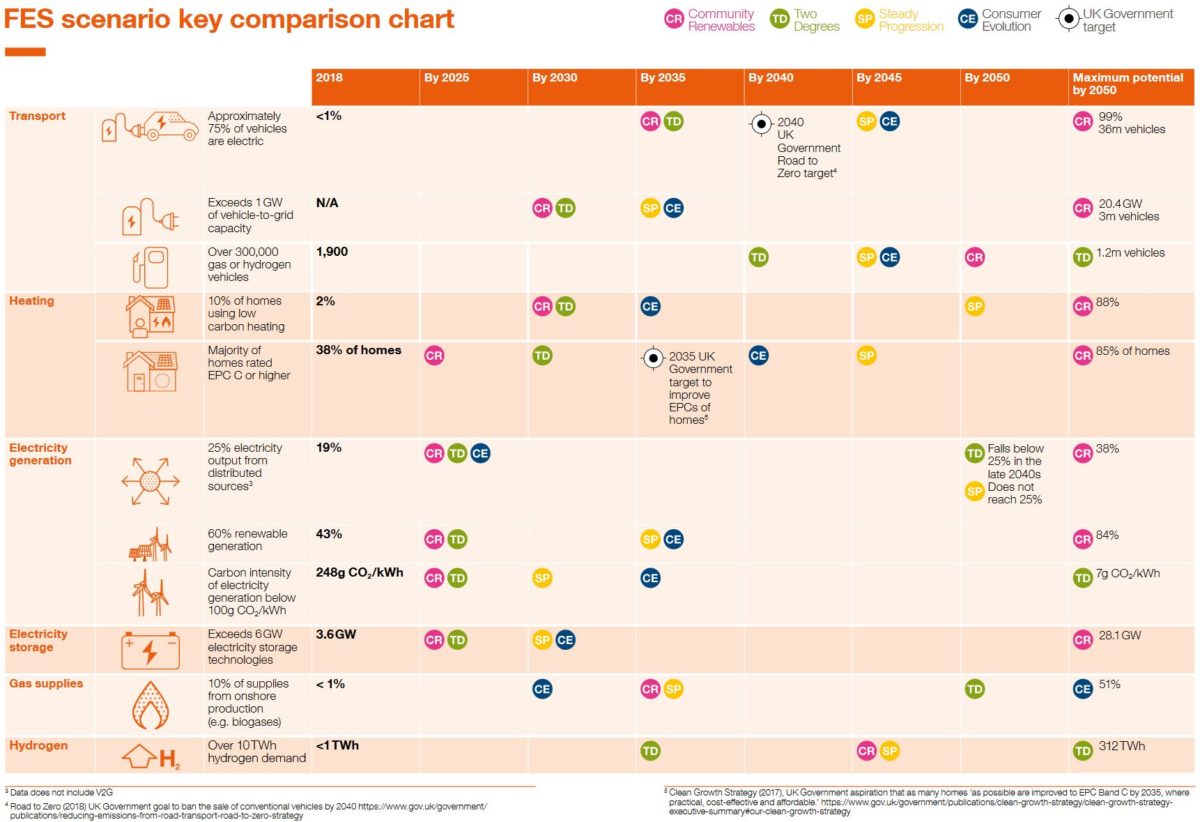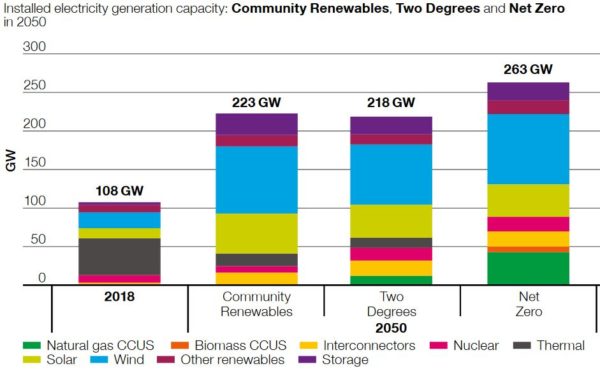Achieving net zero carbon emissions economy by 2050 is feasible for the U.K. using currently available technologies, but will require significant effort. As the U.K. readies to transform its economy to net zero carbon emissions, the national grid operator, National Grid, has released its Future Energy Scenarios 2019 report.
The report's authors examined five scenarios for the transformation of the United Kingdom’s electricity grid. Two scenarios consider what will happen if the current emissions trajectory continues (‘Steady Progression’ scenario) and what the outcome will be if electricity consumers turn current levels of climate awareness into effective decisions on deploying rooftop solar, smart appliances, and the purchases of electric vehicles (‘Consumer Evolution’ scenario). These two scenarios will lead to a 58% reduction of carbon emission by 2050 against a 1990 baseline, failing to meet the 80% target.
National Grid examined two additional more ambitious scenarios in its report. In the ‘Community Renewables’ scenario, the country makes higher use of distributed assets, such as residential rooftop PV, small-scale storage, but also a more significant deployment of EVs.
The other ambitious scenario, ‘Two Degrees,' uses a larger deployment of wind assets and utility-scale solar plants. Both scenarios would reach an 80% reduction of CO2 emission by 2050, against a 1990 baseline.
“Reaching net zero carbon emissions by 2050 is achievable. However, this requires immediate action across all key technologies and policy areas,” National Grid writes in its report referring to the fifth scenario (‘Net Zero’), which supports the carbon neutrality ambitions of outgoing prime minister Theresa May recently.
The net zero scenario would create an annual electricity demand of 491 TWh per year by 2050, compared to a 422 TWh demand if the ‘Two Degrees’ pathway was to be followed. National Grid asserts that this would require 20% more generation capacity of renewables must be built.

Net zero ambitions
The U.K. originally put its Climate Change Act in place in 2008 to reduce carbon emissions by 80% from 1990 baseline levels by 2050. With rising pressure amidst growing public concern to make a move on climate policy, Theresa May's proposal calls for the U.K. economy to go net zero carbon emissions by 2050. A report published at May 2, 2019, by the government's Committee on Climate Change concluded that a shift towards a net zero carbon emissions economy would be possible, using currently available technologies and behavioral changes.
For the enormous emissions burden in the heating sector, for example, a significant number of hydrogen boilers and electric heat pumps must be installed, according to the National Grid study. Currently, most of the heating in the U.K. is done using gas boilers, with very few heat pumps or district heating.
According to the report's data, solar is not gaining its most traction in a net zero scenario. If the ‘Community Renewables’ pathway is followed solar will comprise approximately 50 GW of installed capacity in the 223 GW power market. National Grid suggests that if the ‘Net Zero' scenario is adopted, approximately 40 GW of generation capacity would be covered using natural gas and carbon capture utilization and storage (CCUS) technology, as well as Biomass CCUS. In all of the scenarios, the U.K. grid operator projects a continued role of nuclear power stations, escalating with ambitiousness in targets.

Sector differences
The transportation sector offers the greatest carbon reduction potential among all sectors in the U.K. In 2017, the transport sector emitted 11 Mt CO2e and the report shows that could be reduced to 0.7 Mt CO2e or even 0.5 Mt CO2e in the two scenarios that anticipate an 80% reduction of emissions. For these aims to materialize, a significant chunk of the 36 million cars on Britain’s roads must be replaced with EVs.
But also, in the electricity sector, some significant savings can still be made. Currently blasting out some 73 Mt CO2e, the sector could reduce its contribution to climate change to 7.4 Mt CO2e or 6.6 MT CO2e in the more ambitious scenario.
The heating sector is currently the largest contributor to carbon emissions in the U.K. clocking in at 190 Mt CO2e in the year 2017. Even after the U.K.’s energy system transformation, the heating sector is bound to remain in the inglorious throne as the largest polluter according to the report. Even with the most ambitious 80% reduction scenarios, the sector will blast 63.9 Mt CO2e or 59.7 Mt CO2e, respectively.
Flexibility for net zero
What stands out in the report is that apart from a ramp up in renewables, the grid operator also demonstrates the strong need for demand side response, flexibility, demand shifting, smart EV charging, and vehicle-to-grid applications. Following a net zero agenda will require the industry to decarbonize and create a significant spike in electricity demand. An electric vehicle revolution will also prompt additional challenges to charging patterns.
The report's authors said that it is too early to make definitive assertions about possible solutions for sudden spikes in demand due to specific EV charging patterns, and highlighted that there are still too many unknowns in this calculation. For example, it is not yet clear whether EV users will primarily charge their vehicles at work or home. Either option would significantly shift the charging pattern, and the solutions to ease grid stress could look dramatically different.
National Grid anticipates 65% of EV's on Britan's roads to adopt smart charging. It projects the same rate in an 80% reduction scenario as well as a net zero scenario, and in all ambitious scenarios modeled, 11% of the vehicles are expected to participate in some vehicle-to-grid schemes which would further support the security of supply.
Likewise, National Grid projects that 85% of electricity consumers would have to change to smart appliances across the board of scenarios. This would allow demand from washing machines or other energy intensive home equipment to be aligned with generation patterns, depending on wind and sun conditions. Moreover, this will require a significant digitization effort with new meters, electronics, and millions of new data points to be installed throughout the country.
This content is protected by copyright and may not be reused. If you want to cooperate with us and would like to reuse some of our content, please contact: editors@pv-magazine.com.




3 comments
By submitting this form you agree to pv magazine using your data for the purposes of publishing your comment.
Your personal data will only be disclosed or otherwise transmitted to third parties for the purposes of spam filtering or if this is necessary for technical maintenance of the website. Any other transfer to third parties will not take place unless this is justified on the basis of applicable data protection regulations or if pv magazine is legally obliged to do so.
You may revoke this consent at any time with effect for the future, in which case your personal data will be deleted immediately. Otherwise, your data will be deleted if pv magazine has processed your request or the purpose of data storage is fulfilled.
Further information on data privacy can be found in our Data Protection Policy.